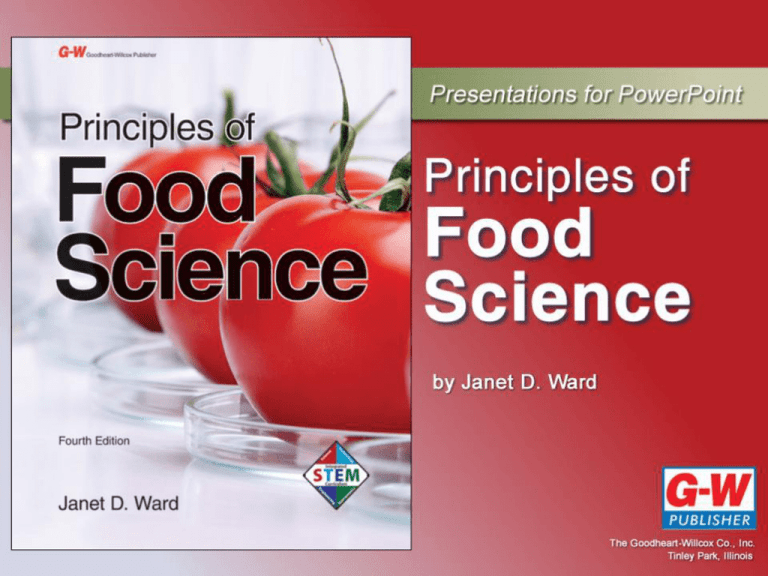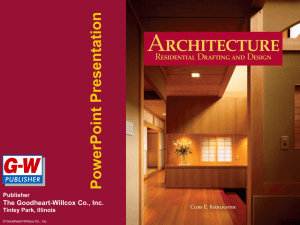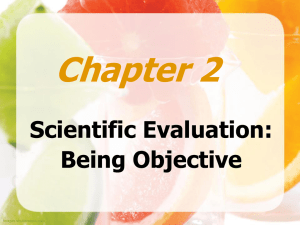Chapter 4 Notes
advertisement

Chapter 4 Basic Food Chemistry: The Nature of Matter Images shutterstock.com Objectives • Describe the basic structure of atoms. • Identify symbols on the periodic table commonly used in food science. • Define ionic and covalent bonding. • Explain the difference between pure substances and mixtures. continued © Goodheart-Willcox Co., Inc. Permission granted to reproduce for educational use only. Objectives • Compare physical and chemical reactions in laboratory experiments. • Balance chemical equations to illustrate simple chemical reactions. © Goodheart-Willcox Co., Inc. Permission granted to reproduce for educational use only. The Basic Nature of Matter • Chemistry is the study of the makeup, structure, and properties of substances and the changes that occur to them – It is the study of matter • An atom is the smallest unit of any elemental substance that maintains the characteristics of that substance continued © Goodheart-Willcox Co., Inc. Permission granted to reproduce for educational use only. The Basic Nature of Matter • Subatomic particles make up an atom – the nucleus, or central core of an atom, contains positively charged protons and neutrons, which have no charge – negatively charged electrons spin around the nucleus in an orbital ©Goodheart-Willcox Publisher © Goodheart-Willcox Co., Inc. continued Permission granted to reproduce for educational use only. The Basic Nature of Matter • An element is a substance that contains only one kind of atom – The number of protons determines the element of an atom – Elements are organized by structure and chemical properties in the periodic table – A system of symbols is used to identify elements © Goodheart-Willcox Co., Inc. Permission granted to reproduce for educational use only. The Periodic Table • Chart showing how elements relate and react to one another • Each cell gives the symbol of the chemical element and includes the – atomic number—number of protons in the nucleus in each atom of that element – atomic mass—sum of the masses of the protons and neutrons in an atom continued © Goodheart-Willcox Co., Inc. Permission granted to reproduce for educational use only. The Periodic Table • The mass of a proton or neutron is defined as equal to one atomic mass unit (AMU) • The mass of an electron is so small it is insignificant • Organization of the cells indicates how elements interact chemically • Elements are grouped as either metals (left side) or nonmetals (right side) continued © Goodheart-Willcox Co., Inc. Permission granted to reproduce for educational use only. The Periodic Table ©Goodheart-Willcox Publisher © Goodheart-Willcox Co., Inc. Permission granted to reproduce for educational use only. Compounds • Compounds are substances in which 2 or more elements chemically combine – The basic unit of any compound is a molecule – Sodium (Na) combines with chloride (Cl) to form sodium chloride (NaCl) or table salt © Aaron Amat/Shutterstock.com © Goodheart-Willcox Co., Inc. Permission granted to reproduce for educational use only. Chemical Formulas • A chemical formula is a combination of symbols of elements making up a compound that – represents one molecule or unit of a compound – has the symbol and subscript numbers of atoms for each element in the compound continued © Goodheart-Willcox Co., Inc. Permission granted to reproduce for educational use only. Chemical Formulas • Knowing how to read a chemical formula can help identify the elements in the substance – H2O is composed of 2 hydrogen atoms and one oxygen atom • Chemical formulas can indicate how atoms are arranged in a molecule continued © Goodheart-Willcox Co., Inc. Permission granted to reproduce for educational use only. Chemical Formulas • Structural formulas for carbon based compounds are written to show how atoms connect to the carbons – Chemical formula for acetic acid is C2H4O2 and structural formula is CH3COOH ©Goodheart-Willcox Publisher © Goodheart-Willcox Co., Inc. Permission granted to reproduce for educational use only. Chemical Bonding • The force that holds 2 atoms together is a chemical bond – Electrons form the bond – Each orbital contains 2 electrons – The space around the nucleus with one or more orbitals is called a shell – Atoms have up to 7 shells – The number of shells determines an element’s position (its row) on the periodic table continued © Goodheart-Willcox Co., Inc. Permission granted to reproduce for educational use only. Chemical Bonding • Atoms are most stable when the outer shell is full of electrons • Atoms that are not stable will share or transfer electrons from another atom • Each column, or group, in the periodic table has the same number of electrons in the outermost shell © Goodheart-Willcox Co., Inc. Permission granted to reproduce for educational use only. Ionic Bonds • An ionic bond occurs when electrons are transferred from one atom to another – This creates a negative charge in one atom and a positive charge in the other – An atom with a positive or negative electrical charge is called an ion – A cation has a positive charge whereas an anion has a negative charge continued © Goodheart-Willcox Co., Inc. Permission granted to reproduce for educational use only. Ionic Bonds • Identical charges repel each other, but opposite charges attract • Substances with ionic bonds – have a crystalline structure – dissolve in water – are metals and nonmetals © Goodheart-Willcox Co., Inc. Permission granted to reproduce for educational use only. Covalent Bonds • Covalent bonds form when atoms share one or more pairs of electrons – Oxygen will share 2 electrons in its outer shell with 2 hydrogen atoms to form water ©Goodheart-Willcox Publisher continued © Goodheart-Willcox Co., Inc. Permission granted to reproduce for educational use only. Covalent Bonds • The Lewis Structure is a shorthand option of diagramming a valence electron – These are electrons in partially full shells that are likely to be shared or transferred – They are represented by a dot next to the symbol for the element – A shell can hold a maximum of 8 electrons ©Goodheart-Willcox Publisher © Goodheart-Willcox Co., Inc. continued Permission granted to reproduce for educational use only. Covalent Bonds • A double bond forms when 2 atoms share 2 pair of electrons – The number of valence electrons around the atoms equals the number of valence electrons in the molecule ©Goodheart-Willcox Publisher © Goodheart-Willcox Co., Inc. Permission granted to reproduce for educational use only. The Classification of Matter • A pure substance is matter in which all the basic units are the same – grouped as elements or compounds • Compounds are categorized into organic compounds or inorganic compounds – Organic compounds contain chains or rings of carbon – Inorganic compounds contain no carbon or only single carbon atoms continued © Goodheart-Willcox Co., Inc. Permission granted to reproduce for educational use only. The Classification of Matter • Mixtures are substances that are put together, but not chemically combined – homogeneous mixtures have a uniform distribution of particles – heterogeneous mixtures have a nonuniform distribution of particles – most homogenous mixtures are a solution in which a solute is dissolved by a solvent © Goodheart-Willcox Co., Inc. Permission granted to reproduce for educational use only. Physical and Chemical Changes • A physical change involves changing shape, size, temperature and/or the physical state – Phase change is a physical change in the visible structure without changing the molecular structure – Any phase change is an example of a reversible physical change continued © Goodheart-Willcox Co., Inc. Permission granted to reproduce for educational use only. Physical and Chemical Changes • A chemical change occurs whenever new substances with different chemical and physical properties are formed – This produces a change in color, odor, or flavor, or releases a gas • Physical and chemical changes may or may not be reversible © Goodheart-Willcox Co., Inc. Permission granted to reproduce for educational use only. Chemical Equations • Chemical formulas are used to represent the compounds involved in a chemical change – Chemical formulas on the left side of the equation are called reactants – Chemical formulas on the right side of the equation are called products ©Goodheart-Willcox Publisher continued © Goodheart-Willcox Co., Inc. Permission granted to reproduce for educational use only. Chemical Equations • The law of conservation of matter states that matter can be changed, but not created or destroyed – This is shown in chemical equations • Equations must balance by having the same number of each type of atom on both sides of the equation ©Goodheart-Willcox Publisher © Goodheart-Willcox Co., Inc. Permission granted to reproduce for educational use only. Recap • Atoms are composed of – a nucleus containing protons and neutrons – electrons moving about outside the nucleus • The periodic table is a chart that shows how elements relate and react to one another • Atoms form ionic and covalent bonds to create molecules and compounds continued © Goodheart-Willcox Co., Inc. Permission granted to reproduce for educational use only. Recap • Pure substances have the same basic units, whereas mixtures are substances put together, but not chemically combined • Changes to food compounds can be described as both physical and chemical • Chemical equations are used to describe chemical changes © Goodheart-Willcox Co., Inc. Permission granted to reproduce for educational use only.



